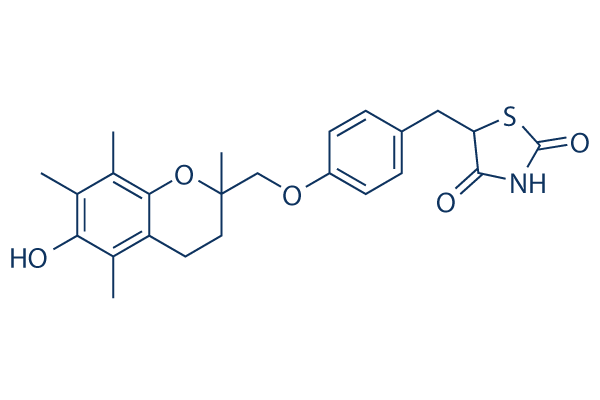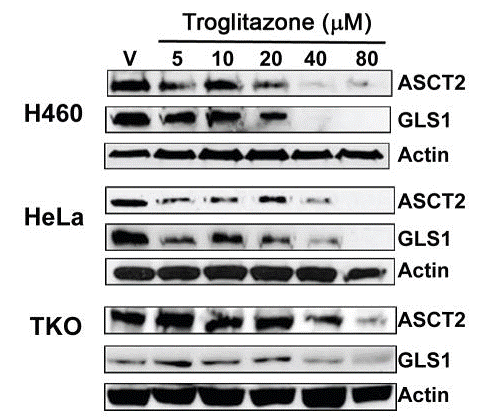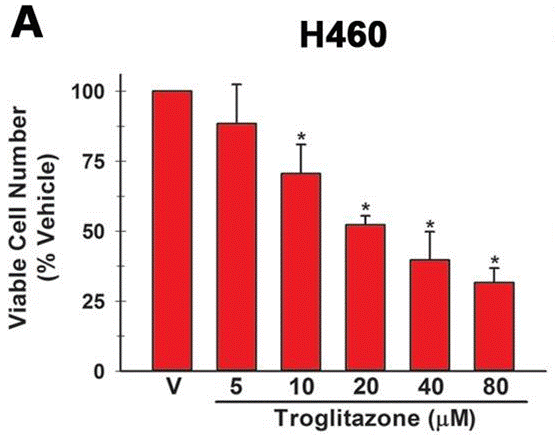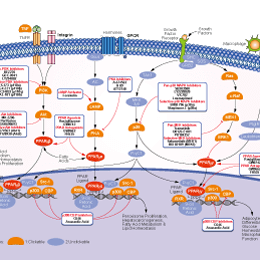
- Bioactive Compounds
- By Signaling Pathways
- PI3K/Akt/mTOR
- Epigenetics
- Methylation
- Immunology & Inflammation
- Protein Tyrosine Kinase
- Angiogenesis
- Apoptosis
- Autophagy
- ER stress & UPR
- JAK/STAT
- MAPK
- Cytoskeletal Signaling
- Cell Cycle
- TGF-beta/Smad
- DNA Damage/DNA Repair
- Compound Libraries
- Popular Compound Libraries
- Customize Library
- Clinical and FDA-approved Related
- Bioactive Compound Libraries
- Inhibitor Related
- Natural Product Related
- Metabolism Related
- Cell Death Related
- By Signaling Pathway
- By Disease
- Anti-infection and Antiviral Related
- Neuronal and Immunology Related
- Fragment and Covalent Related
- FDA-approved Drug Library
- FDA-approved & Passed Phase I Drug Library
- Preclinical/Clinical Compound Library
- Bioactive Compound Library-I
- Bioactive Compound Library-Ⅱ
- Kinase Inhibitor Library
- Express-Pick Library
- Natural Product Library
- Human Endogenous Metabolite Compound Library
- Alkaloid Compound LibraryNew
- Angiogenesis Related compound Library
- Anti-Aging Compound Library
- Anti-alzheimer Disease Compound Library
- Antibiotics compound Library
- Anti-cancer Compound Library
- Anti-cancer Compound Library-Ⅱ
- Anti-cancer Metabolism Compound Library
- Anti-Cardiovascular Disease Compound Library
- Anti-diabetic Compound Library
- Anti-infection Compound Library
- Antioxidant Compound Library
- Anti-parasitic Compound Library
- Antiviral Compound Library
- Apoptosis Compound Library
- Autophagy Compound Library
- Calcium Channel Blocker LibraryNew
- Cambridge Cancer Compound Library
- Carbohydrate Metabolism Compound LibraryNew
- Cell Cycle compound library
- CNS-Penetrant Compound Library
- Covalent Inhibitor Library
- Cytokine Inhibitor LibraryNew
- Cytoskeletal Signaling Pathway Compound Library
- DNA Damage/DNA Repair compound Library
- Drug-like Compound Library
- Endoplasmic Reticulum Stress Compound Library
- Epigenetics Compound Library
- Exosome Secretion Related Compound LibraryNew
- FDA-approved Anticancer Drug LibraryNew
- Ferroptosis Compound Library
- Flavonoid Compound Library
- Fragment Library
- Glutamine Metabolism Compound Library
- Glycolysis Compound Library
- GPCR Compound Library
- Gut Microbial Metabolite Library
- HIF-1 Signaling Pathway Compound Library
- Highly Selective Inhibitor Library
- Histone modification compound library
- HTS Library for Drug Discovery
- Human Hormone Related Compound LibraryNew
- Human Transcription Factor Compound LibraryNew
- Immunology/Inflammation Compound Library
- Inhibitor Library
- Ion Channel Ligand Library
- JAK/STAT compound library
- Lipid Metabolism Compound LibraryNew
- Macrocyclic Compound Library
- MAPK Inhibitor Library
- Medicine Food Homology Compound Library
- Metabolism Compound Library
- Methylation Compound Library
- Mouse Metabolite Compound LibraryNew
- Natural Organic Compound Library
- Neuronal Signaling Compound Library
- NF-κB Signaling Compound Library
- Nucleoside Analogue Library
- Obesity Compound Library
- Oxidative Stress Compound LibraryNew
- Plant Extract Library
- Phenotypic Screening Library
- PI3K/Akt Inhibitor Library
- Protease Inhibitor Library
- Protein-protein Interaction Inhibitor Library
- Pyroptosis Compound Library
- Small Molecule Immuno-Oncology Compound Library
- Mitochondria-Targeted Compound LibraryNew
- Stem Cell Differentiation Compound LibraryNew
- Stem Cell Signaling Compound Library
- Natural Phenol Compound LibraryNew
- Natural Terpenoid Compound LibraryNew
- TGF-beta/Smad compound library
- Traditional Chinese Medicine Library
- Tyrosine Kinase Inhibitor Library
- Ubiquitination Compound Library
-
Cherry Picking
You can personalize your library with chemicals from within Selleck's inventory. Build the right library for your research endeavors by choosing from compounds in all of our available libraries.
Please contact us at [email protected] to customize your library.
You could select:
- Antibodies
- Bioreagents
- qPCR
- 2x SYBR Green qPCR Master Mix
- 2x SYBR Green qPCR Master Mix(Low ROX)
- 2x SYBR Green qPCR Master Mix(High ROX)
- Protein Assay
- Protein A/G Magnetic Beads for IP
- Anti-Flag magnetic beads
- Anti-Flag Affinity Gel
- Anti-Myc magnetic beads
- Anti-HA magnetic beads
- Magnetic Separator
- Poly DYKDDDDK Tag Peptide lyophilized powder
- Protease Inhibitor Cocktail
- Protease Inhibitor Cocktail (EDTA-Free, 100X in DMSO)
- Phosphatase Inhibitor Cocktail (2 Tubes, 100X)
- Cell Biology
- Cell Counting Kit-8 (CCK-8)
- Animal Experiment
- Mouse Direct PCR Kit (For Genotyping)
- New Products
- Contact Us
Troglitazone
Synonyms: CS-045, Romglizone
Troglitazone is a potent agonist for the peroxisome proliferator-activated receptor-(PPAR) that is a ligand activated transcription factor regulating cell differentiation and growth. Troglitazone induces autophagy, apoptosis and necroptosis in bladder cancer cells. Troglitazone prevents RSL3-induced ferroptosis and lipid peroxidation in Pfa1 cells.

Troglitazone Chemical Structure
CAS No. 97322-87-7
Purity & Quality Control
Batch:
Purity:
99.47%
99.47
Troglitazone Related Products
| Related Targets | PPARα PPARβ/δ PPARγ PPARδ | Click to Expand |
|---|---|---|
| Related Products | T0070907 GW9662 GW6471 WY-14643 (Pirinixic Acid) GSK3787 GW0742 AZ6102 Astaxanthin Eupatilin GSK0660 Oroxin A Harmine Palmitoylethanolamide Lanifibranor (IVA-337) DG172 dihydrochloride Glabridin Ciprofibrate Clofibric Acid Alpinetin Elafibranor Daidzein Gypenoside XLIX | Click to Expand |
| Related Compound Libraries | Metabolism Compound Library Anti-cancer Metabolism Compound Library Glutamine Metabolism Compound Library Carbohydrate Metabolism Compound Library Lipid Metabolism Compound Library | Click to Expand |
Signaling Pathway
Cell Data
| Cell Lines | Assay Type | Concentration | Incubation Time | Formulation | Activity Description | PMID |
|---|---|---|---|---|---|---|
| 3T3-L1 cells | Function assay | Effective concentration for 50% enhancement of insulin-induced triglyceride accumulation in 3T3-L1 cells, EC50=0.13 μM | 9599241 | |||
| PC12 cells | Proliferation assay | Concentration required for 50% inhibition of cell proliferation in PC12 cells using sulforhodamine B assay, IC50=15 Μm | 15109648 | |||
| A549 | Growth inhibition assay | Inhibition of human lung cancer cell line (A549) by 50% in sulforhodamine B assay, GI50=15 μM | 15454234 | |||
| 3T3L1 cells | Function assay | Increase in 2-deoxyglucose uptake in mouse 3T3L1 cells at 3 uM by liquid scintillation counter | 18477507 | |||
| ST-13 cells | Function assay | 5 μM | 11 days | Induction of preadipocyte differentiation in mouse ST-13 cells assessed as lipid accumulation at 5 uM within 11 days by oil red-staining relative to control | 19268587 | |
| HEK293 cells | Function assay | Agonist activity at PPARgamma expressed in HEK293 cells assessed as induction of receptor interaction with steroid receptor coactivator-1 by EYFP based reporter gene assay | 16680159 | |||
| MA104 cells | Cytotoxicity assay | 24 h | Cytotoxicity against monkey MA104 cells after 24 hrs, TD50=18.5 μM | 22365411 | ||
| MDA-MB-231 cells | Proliferation assay | 24 h | Antiproliferative activity hormone-independent human MDA-MB-231 cells after 24 hrs by luminescent cell viability assay, IC50=15.7 μM | 22409968 | ||
| MCF7 cells | Proliferation assay | 24 h | Antiproliferative activity hormone-dependent human MCF7 cells after 24 hrs by luminescent cell viability assay, IC50=35.4 μM | 22409968 | ||
| HepG2 cells | Function assay | 20 h | Transactivation of GAL4-fused PPARgamma LBD expressed in HepG2 cells after 20 hrs by luminescence assay, EC50=0.73 μM | 22381047 | ||
| LNCAP cells | Cytotoxicity assay | 24 h | Cytotoxicity against human LNCAP cells after 24 hrs by MTT assay, IC50=22 μM | 22546208 | ||
| PC3 cells | Cytotoxicity assay | 24 h | Cytotoxicity against human PC3 cells after 24 hrs by MTT assay, IC50=30 μM | 22546208 | ||
| HepG2 cells | Function assay | 50 μM | 24 h | Induction of p53 protein level in human HepG2 cells at 50 uM up to 24 hrs by immunoblot analysis | 25851939 | |
| CV-1 cells | Function assay | Activation of peroxisome proliferator activated receptor gamma measured by induction of 50% of maximum alkaline phosphatase activity, transfection assay in CV-1 cells, EC50=0.53703 μM | 9836620 | |||
| CHO cells | Function assay | 24 h | Agonist activity at human PPARgamma expressed in CHO cells co-transfected with pGL3-PPRE3-TK-luc assessed as transactivation after 24 hrs by firefly luciferase reporter gene assay, EC50=0.44 μM | 22342624 | ||
| HepG2 cells | Function assay | 0.5-12.5 μM | Agonist activity at PPARgamma in human HepG2 cells assessed as down-regulation of glucose-6-phosphatase at 0.5 to 12.5 uM by real-time PCR method | 22342624 | ||
| 3T3L1 cells | Function assay | Agonist activity at PPARgamma in mouse 3T3L1 cells, EC50=1 μM | 21493073 | |||
| HepG2 cells | Function assay | 0.5-12.5 μM | Agonist activity at PPARgamma in human HepG2 cells assessed as down-regulation of phosphoenolpyruvate carboxykinase at 0.5 to 12.5 uM by real-time PCR method | 22342624 | ||
| HepG2 cells | Function assay | Agonist activity at PPARgamma in human HepG2 cells assessed as downregulation of phosphoenolpyruvate carboxykinase mRNA by RT-PCR analysis | 22424300 | |||
| HEK293T cells | Function assay | Inhibition of mouse Ido2 transfected in HEK293T cells using L-tryptophan as substrate assessed as kynurenine formation after 45 mins by spectrophotometric analysis, IC50=4.5 Μm | 23122865 | |||
| HepG2 cells | Function assay | Agonist activity at PPARgamma in human HepG2 cells assessed as downregulation of glucose-6-phosphatase mRNA by RT-PCR analysis | 22424300 | |||
| HEK293 cells | Function assay | Activation of PPARgamma transfected in HEK293 cells after 18 hrs by firefly luciferase reporter gene-based luminescence assay relative to control, EC50=0.4 μM | 21800856 | |||
| rat ventricular myocytes | Function assay | Inhibition of L-type calcium channel measured using whole-cell patch clamp in rat ventricular myocytes, IC50=9.5 μM | 22761000 | |||
| HepG2 (DPX-2) cells | Function assay | 24 h | Activation of human PXR expressed in human HepG2 (DPX-2) cells assessed as induction of CYP3A4 after 24 hrs by luminescent analysis, EC50=6.9 μM | 20966043 | ||
| CV1 cells | Function assay | Transactivation of human PPARgamma expressed in african green monkey CV1 cells by luciferase reporter gene assay, EC50=0.4 μM | 22579420 | |||
| CHO cells | Function assay | Agonist activity at human recombinant PPARgamma expressed in CHO cells cotransfected with pGL3-PPRE3-TK-luc reporter assessed as beta-galactosidase activity at after 24 hrs by luciferase based transactivation assay, EC50=0.44 μM | 22424300 | |||
| HepG2 cells | Function assay | Transactivation of GAL4-fused PPARgamma ligand binding domain transfected in human HepG2 cells after 20 hrs by luciferase reporter gene assay, EC50=0.72 μM | 23031596 | |||
| HEK293 cells | Function assay | 10 μM | 24 h | Transactivation of PPAR-gamma transfected in HEK293 cells at 10 uM after 24 hrs by luciferase reporter gene assay | 22579484 | |
| Click to View More Cell Line Experimental Data | ||||||
Biological Activity
| Description | Troglitazone is a potent agonist for the peroxisome proliferator-activated receptor-(PPAR) that is a ligand activated transcription factor regulating cell differentiation and growth. Troglitazone induces autophagy, apoptosis and necroptosis in bladder cancer cells. Troglitazone prevents RSL3-induced ferroptosis and lipid peroxidation in Pfa1 cells. | ||
|---|---|---|---|
| Targets |
|
| In vitro | ||||
| In vitro | Troglitazone significantly inhibits cell growth by cell cycle arrest and apoptotic cell death. Troglitazone also downregulates surface expression of CD97, a novel dedifferentiation marker, in FTC-133 cells and upregulated sodium iodide symporter (NIS) mRNA in TPC-1 and FTC-133 cells. Troglitazone, a PPARγ agonist, induces antiproliferation and redifferentiation in thyroid cancer cell lines[1]. Troglitazone induces Erk phosphorylation in human prostate cancer cells via a PPARγ-independent signaling pathway[2]. TGZ(Troglitazone) up-regulates nitric oxide synthesis, induces the p53 pathway, inhibits cholesterol biosynthesis, induces p21 cyclin-dependent kinase inhibitor, has antioxidant function, and activates extracellular signal-regulated protein kinase (ERK) in a PPARγ-independent manner. TGZ induces Egr-1 expression by transcriptional and post-transcriptional regulation. Egr-1 induction by TGZ results in the increase of binding affinity and transactivation of the promoter containing Egr-1 consensus sequences, thereby possibly inducing other anti-tumorigenic proteins[3]. |
|||
|---|---|---|---|---|
| Cell Research | Cell lines | Thyroid cancer cell lines TPC-1, FTC-133, FTC-236, FTC-238, XTC-1 and ARO82-1 cell lines | ||
| Concentrations | 5, 10, 20, 40 μM | |||
| Incubation Time | 0, 2, 4, and 6 days | |||
| Method | Growth experiments are done in a 96-well plate in hexaplicate. Cells at 85%-100% confluency are harvested with 1×Trypsin/EDTA solution and seeded into a 96-well plate at 3-5×103 cells per well depending upon growth rate and maintained in 200 μL H5 medium in a humidified incubator. After 24 hours, cells are incubated with different concentrations of troglitazone and the media was changed daily. Colorometric dimethyl-thiazol-diphenyltetrazolium bromide (MTT) proliferation assays are performed at 0, 2, 4, and 6 days after treatment. MTT (400 μg/mL) is added to each well and incubated for 3 hours. It is solubilized with 0.04 N HCl/iso-propanol/3% SDS and incubated for 1 hour. The optical densities in the 96-well plates are determined using an enzyme-linked immunosorbent assay (ELISA) microplate reader at 595 nm/620 nm. |
|||
| Experimental Result Images | Methods | Biomarkers | Images | PMID |
| Western blot | ASCT2 / GLS1 c-Myc |

|
25872876 | |
| Growth inhibition assay | Cell viability |

|
25872876 | |
| In Vivo | ||
| In vivo | Troglitazone is an effective antidiabetic drug with a fundamentally new mechanism of action. However, within a year after its widespread use, individual cases of liver injury and failure are reported[5]. TGZ significantly inhibits tumor growth of human colorectal cancer cells (HCT-116), human breast cancer cells (MCF-7), and human prostate cancer cells (PC-3) in immunodeficient mice[3]. Troglitazone attenuates pancreatic damage and inflammation in experimental chronic pancreatitis[4]. |
|
|---|---|---|
| Animal Research | Animal Models | C57BL/6 mice |
| Dosages | 0.2% (with chow) | |
| Administration | oral administration | |
Chemical Information & Solubility
| Molecular Weight | 441.54 | Formula | C24H27NO5S |
| CAS No. | 97322-87-7 | SDF | Download Troglitazone SDF |
| Smiles | CC1=C(C2=C(CCC(O2)(C)COC3=CC=C(C=C3)CC4C(=O)NC(=O)S4)C(=C1O)C)C | ||
| Storage (From the date of receipt) | |||
|
In vitro |
DMSO : 88 mg/mL ( (199.3 mM) Moisture-absorbing DMSO reduces solubility. Please use fresh DMSO.) Ethanol : 15 mg/mL Water : Insoluble |
Molecular Weight Calculator |
|
In vivo Add solvents to the product individually and in order. |
In vivo Formulation Calculator |
||||
Preparing Stock Solutions
Molarity Calculator
In vivo Formulation Calculator (Clear solution)
Step 1: Enter information below (Recommended: An additional animal making an allowance for loss during the experiment)
mg/kg
g
μL
Step 2: Enter the in vivo formulation (This is only the calculator, not formulation. Please contact us first if there is no in vivo formulation at the solubility Section.)
% DMSO
%
% Tween 80
% ddH2O
%DMSO
%
Calculation results:
Working concentration: mg/ml;
Method for preparing DMSO master liquid: mg drug pre-dissolved in μL DMSO ( Master liquid concentration mg/mL, Please contact us first if the concentration exceeds the DMSO solubility of the batch of drug. )
Method for preparing in vivo formulation: Take μL DMSO master liquid, next addμL PEG300, mix and clarify, next addμL Tween 80, mix and clarify, next add μL ddH2O, mix and clarify.
Method for preparing in vivo formulation: Take μL DMSO master liquid, next add μL Corn oil, mix and clarify.
Note: 1. Please make sure the liquid is clear before adding the next solvent.
2. Be sure to add the solvent(s) in order. You must ensure that the solution obtained, in the previous addition, is a clear solution before proceeding to add the next solvent. Physical methods such
as vortex, ultrasound or hot water bath can be used to aid dissolving.
Tech Support
Answers to questions you may have can be found in the inhibitor handling instructions. Topics include how to prepare stock solutions, how to store inhibitors, and issues that need special attention for cell-based assays and animal experiments.
Tel: +1-832-582-8158 Ext:3
If you have any other enquiries, please leave a message.
* Indicates a Required Field
Tags: buy Troglitazone | Troglitazone ic50 | Troglitazone price | Troglitazone cost | Troglitazone solubility dmso | Troglitazone purchase | Troglitazone manufacturer | Troglitazone research buy | Troglitazone order | Troglitazone mouse | Troglitazone chemical structure | Troglitazone mw | Troglitazone molecular weight | Troglitazone datasheet | Troglitazone supplier | Troglitazone in vitro | Troglitazone cell line | Troglitazone concentration | Troglitazone nmr







































